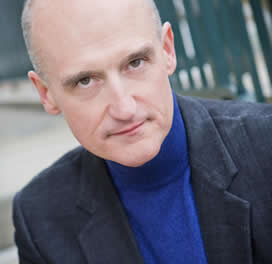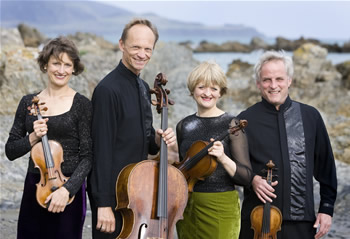It is no secret that June across the Atlantic states of the U.S. has been uncharacteristically hot. A cursory look at recent CVNC reviews will reveal how uncomfortable the region has been. Usually, the mountains of western NC enjoy some relief owing to the formula: for every one thousand feet above sea level the temperature is lower by 1 degree centigrade. But ninety degrees anywhere is still hot, and on this day, Asheville’s 2,100 feet of altitude could not escape the June heat wave. Fortunately, for this eighth edition of the annual Keowee Chamber Music Festival we met in the stone and wood, high ceiling First Presbyterian Church downtown, well entrenched with climate controlled comforts and glorious sounds.
Program I (which is actually two different programs anchored by four shared works) featured four musicians and was dominated by some cool French composers and sounds. The composers were Frank Martin, Francis Poulenc, Eugene Goossens, Calvin Hampton, Olivier Messiaen, and Madeleine Dring. The players were Kate Steinbeck, flute, Alicia Chapman, oboe, Fabio Parrini, piano, and Eric Wall, organ. This combination of personalities cannot fail to provoke the ears, and this musical journey was far better played than many similar programs offered by the older and august Brevard Music Center.
The opening piece, Sonata da Chiesa by Frank Martin (1890-1974), is a two-movement work for organ and flute written in 1938. Here, the moody Martin is at his drifting best with an opening chorale-type movement in the organ while the flute searches, and searches, and searches. The second movement began with a monologue by the organ, later joined by the flute, and then the searching stopped. I was glad to hear this piece but still don’t understand why it is so memorable.
Next we heard another moody work, the Sonata for oboe and piano by Poulenc. Alicia Chapman had the measure of this three-movement piece, written in 1932. The movements were titled Elégie (Paisiblement, Sans Presser), Scherzo (Très animé), ending with Déploration (Très calme), which shows the architectural high point right in the middle. The blistering scherzo was bracketed by breezy, atmospheric and wandering aural terrain enriched by excellent dynamic inflection. Parrini’s accompaniment revealed him an accomplished pianist and excellent collaborator.
The third work was the Pastorale et Arlequinade by composer and conductor Eugene Goossens (1893-1962). He might be better known for introducing England to Stravinsky’s Le Sacre du Printemps ten years after the première in Paris, or for his initiative during the ’40s to inspire patriotic works from composers, an act that ultimately led to Copland’s “Fanfare for the Common Man” (the first performance of which was given when Goossens was conductor of the Cincinnati Symphony Orchestra, between 1931 and 1946). Yet we don’t hear his compositions too often. This two-movement pastorale for flute, oboe, and piano features a sunny and lyric adagio and then a brisk scherzo movement that ended the run-up to intermission. Kate Steinbeck plays a black, wood flute manufactured by the Abell Flute Company in Asheville. This is worth mentioning because the sound of her instrument along with Chapman’s similar wood oboe clearly made a more uniform hue to the timbre from both instruments and, as a result, a more balanced point of departure for making interpretive gestures. Like a rock, the Italian Parrini held the piano in check so the woodwinds could fly, then flew on his own when the score called the piano to center stage.
The second half opened with a set of Variations on “Amazing Grace” for English horn and organ by American Organ legend Calvin Hampton. This is a fairly straightforward approach to the form with one important exception: at one point Hampton asks the English horn to play a “chord,” and for those of you scoring at home, you’ll recall this is a single note instrument, right? Well, it turns out that if you hold a combination of certain keys in just the right way – I suppose half open/closed and blow a certain register – the instrument will in fact produce a three-note chord! Now we should probably caution the reader that we’re not talking about a major triad but something more like a submarine dive alarm or old fashion klaxon found on cars of the twenties. Interesting. I’m not sure about the art part, but interesting.
Olivier Messiaen came next, with the Le Merle Noir (Blackbird), written in 1932 for flute and piano. Messiaen was an organist and ornithologist, with the ability to distinguish among 700 types of bird calls. (Musicians! Go figure.) This work is a tribute to the blackbird, and Parrini explored many textures on the piano to enhance the foundations of the piece and compliment the flute melodies. The intonation of the two instruments, regardless of register, was wonderful.
The program ended with a work by English composer Madeleine Dring (1923-77). She studied at the Royal College of Music under Gordon Jacob and Ralph Vaughan Williams. Throughout her career, Dring’s style was typically light and tuneful. Her output was mostly in smaller forms, and she composed a good deal of solo piano and chamber music including a complete one-act opera, Cupboard Love, a dance drama, The Fair Queen of Wu, over 27 instrumental and vocal works, and 25 works for theatre, drama, and television. Her Trio for flute, oboe and piano, composed in 1968, was a perfect ending. Sunny and tonal, the three movements seemed to fly by like a welcome dessert after a fine but complex meal.
Program II is coming June 10-15.
Edited 6/10/08.












